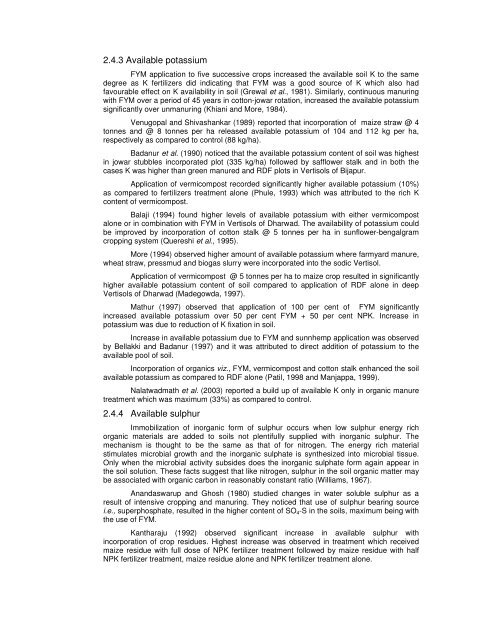impact of farmers' organic farming practices on soil properties in ...
impact of farmers' organic farming practices on soil properties in ...
impact of farmers' organic farming practices on soil properties in ...
Create successful ePaper yourself
Turn your PDF publications into a flip-book with our unique Google optimized e-Paper software.
2.4.3 Available potassium<br />
FYM applicati<strong>on</strong> to five successive crops <strong>in</strong>creased the available <strong>soil</strong> K to the same<br />
degree as K fertilizers did <strong>in</strong>dicat<strong>in</strong>g that FYM was a good source <str<strong>on</strong>g>of</str<strong>on</strong>g> K which also had<br />
favourable effect <strong>on</strong> K availability <strong>in</strong> <strong>soil</strong> (Grewal et al., 1981). Similarly, c<strong>on</strong>t<strong>in</strong>uous manur<strong>in</strong>g<br />
with FYM over a period <str<strong>on</strong>g>of</str<strong>on</strong>g> 45 years <strong>in</strong> cott<strong>on</strong>-jowar rotati<strong>on</strong>, <strong>in</strong>creased the available potassium<br />
significantly over unmanur<strong>in</strong>g (Khiani and More, 1984).<br />
Venugopal and Shivashankar (1989) reported that <strong>in</strong>corporati<strong>on</strong> <str<strong>on</strong>g>of</str<strong>on</strong>g> maize straw @ 4<br />
t<strong>on</strong>nes and @ 8 t<strong>on</strong>nes per ha released available potassium <str<strong>on</strong>g>of</str<strong>on</strong>g> 104 and 112 kg per ha,<br />
respectively as compared to c<strong>on</strong>trol (88 kg/ha).<br />
Badanur et al. (1990) noticed that the available potassium c<strong>on</strong>tent <str<strong>on</strong>g>of</str<strong>on</strong>g> <strong>soil</strong> was highest<br />
<strong>in</strong> jowar stubbles <strong>in</strong>corporated plot (335 kg/ha) followed by safflower stalk and <strong>in</strong> both the<br />
cases K was higher than green manured and RDF plots <strong>in</strong> Vertisols <str<strong>on</strong>g>of</str<strong>on</strong>g> Bijapur.<br />
Applicati<strong>on</strong> <str<strong>on</strong>g>of</str<strong>on</strong>g> vermicompost recorded significantly higher available potassium (10%)<br />
as compared to fertilizers treatment al<strong>on</strong>e (Phule, 1993) which was attributed to the rich K<br />
c<strong>on</strong>tent <str<strong>on</strong>g>of</str<strong>on</strong>g> vermicompost.<br />
Balaji (1994) found higher levels <str<strong>on</strong>g>of</str<strong>on</strong>g> available potassium with either vermicompost<br />
al<strong>on</strong>e or <strong>in</strong> comb<strong>in</strong>ati<strong>on</strong> with FYM <strong>in</strong> Vertisols <str<strong>on</strong>g>of</str<strong>on</strong>g> Dharwad. The availability <str<strong>on</strong>g>of</str<strong>on</strong>g> potassium could<br />
be improved by <strong>in</strong>corporati<strong>on</strong> <str<strong>on</strong>g>of</str<strong>on</strong>g> cott<strong>on</strong> stalk @ 5 t<strong>on</strong>nes per ha <strong>in</strong> sunflower-bengalgram<br />
cropp<strong>in</strong>g system (Quereshi et al., 1995).<br />
More (1994) observed higher amount <str<strong>on</strong>g>of</str<strong>on</strong>g> available potassium where farmyard manure,<br />
wheat straw, pressmud and biogas slurry were <strong>in</strong>corporated <strong>in</strong>to the sodic Vertisol.<br />
Applicati<strong>on</strong> <str<strong>on</strong>g>of</str<strong>on</strong>g> vermicompost @ 5 t<strong>on</strong>nes per ha to maize crop resulted <strong>in</strong> significantly<br />
higher available potassium c<strong>on</strong>tent <str<strong>on</strong>g>of</str<strong>on</strong>g> <strong>soil</strong> compared to applicati<strong>on</strong> <str<strong>on</strong>g>of</str<strong>on</strong>g> RDF al<strong>on</strong>e <strong>in</strong> deep<br />
Vertisols <str<strong>on</strong>g>of</str<strong>on</strong>g> Dharwad (Madegowda, 1997).<br />
Mathur (1997) observed that applicati<strong>on</strong> <str<strong>on</strong>g>of</str<strong>on</strong>g> 100 per cent <str<strong>on</strong>g>of</str<strong>on</strong>g> FYM significantly<br />
<strong>in</strong>creased available potassium over 50 per cent FYM + 50 per cent NPK. Increase <strong>in</strong><br />
potassium was due to reducti<strong>on</strong> <str<strong>on</strong>g>of</str<strong>on</strong>g> K fixati<strong>on</strong> <strong>in</strong> <strong>soil</strong>.<br />
Increase <strong>in</strong> available potassium due to FYM and sunnhemp applicati<strong>on</strong> was observed<br />
by Bellakki and Badanur (1997) and it was attributed to direct additi<strong>on</strong> <str<strong>on</strong>g>of</str<strong>on</strong>g> potassium to the<br />
available pool <str<strong>on</strong>g>of</str<strong>on</strong>g> <strong>soil</strong>.<br />
Incorporati<strong>on</strong> <str<strong>on</strong>g>of</str<strong>on</strong>g> <str<strong>on</strong>g>organic</str<strong>on</strong>g>s viz., FYM, vermicompost and cott<strong>on</strong> stalk enhanced the <strong>soil</strong><br />
available potassium as compared to RDF al<strong>on</strong>e (Patil, 1998 and Manjappa, 1999).<br />
Nalatwadmath et al. (2003) reported a build up <str<strong>on</strong>g>of</str<strong>on</strong>g> available K <strong>on</strong>ly <strong>in</strong> <str<strong>on</strong>g>organic</str<strong>on</strong>g> manure<br />
treatment which was maximum (33%) as compared to c<strong>on</strong>trol.<br />
2.4.4 Available sulphur<br />
Immobilizati<strong>on</strong> <str<strong>on</strong>g>of</str<strong>on</strong>g> <strong>in</strong><str<strong>on</strong>g>organic</str<strong>on</strong>g> form <str<strong>on</strong>g>of</str<strong>on</strong>g> sulphur occurs when low sulphur energy rich<br />
<str<strong>on</strong>g>organic</str<strong>on</strong>g> materials are added to <strong>soil</strong>s not plentifully supplied with <strong>in</strong><str<strong>on</strong>g>organic</str<strong>on</strong>g> sulphur. The<br />
mechanism is thought to be the same as that <str<strong>on</strong>g>of</str<strong>on</strong>g> for nitrogen. The energy rich material<br />
stimulates microbial growth and the <strong>in</strong><str<strong>on</strong>g>organic</str<strong>on</strong>g> sulphate is synthesized <strong>in</strong>to microbial tissue.<br />
Only when the microbial activity subsides does the <strong>in</strong><str<strong>on</strong>g>organic</str<strong>on</strong>g> sulphate form aga<strong>in</strong> appear <strong>in</strong><br />
the <strong>soil</strong> soluti<strong>on</strong>. These facts suggest that like nitrogen, sulphur <strong>in</strong> the <strong>soil</strong> <str<strong>on</strong>g>organic</str<strong>on</strong>g> matter may<br />
be associated with <str<strong>on</strong>g>organic</str<strong>on</strong>g> carb<strong>on</strong> <strong>in</strong> reas<strong>on</strong>ably c<strong>on</strong>stant ratio (Williams, 1967).<br />
Anandaswarup and Ghosh (1980) studied changes <strong>in</strong> water soluble sulphur as a<br />
result <str<strong>on</strong>g>of</str<strong>on</strong>g> <strong>in</strong>tensive cropp<strong>in</strong>g and manur<strong>in</strong>g. They noticed that use <str<strong>on</strong>g>of</str<strong>on</strong>g> sulphur bear<strong>in</strong>g source<br />
i.e., superphosphate, resulted <strong>in</strong> the higher c<strong>on</strong>tent <str<strong>on</strong>g>of</str<strong>on</strong>g> SO4-S <strong>in</strong> the <strong>soil</strong>s, maximum be<strong>in</strong>g with<br />
the use <str<strong>on</strong>g>of</str<strong>on</strong>g> FYM.<br />
Kantharaju (1992) observed significant <strong>in</strong>crease <strong>in</strong> available sulphur with<br />
<strong>in</strong>corporati<strong>on</strong> <str<strong>on</strong>g>of</str<strong>on</strong>g> crop residues. Highest <strong>in</strong>crease was observed <strong>in</strong> treatment which received<br />
maize residue with full dose <str<strong>on</strong>g>of</str<strong>on</strong>g> NPK fertilizer treatment followed by maize residue with half<br />
NPK fertilizer treatment, maize residue al<strong>on</strong>e and NPK fertilizer treatment al<strong>on</strong>e.

















